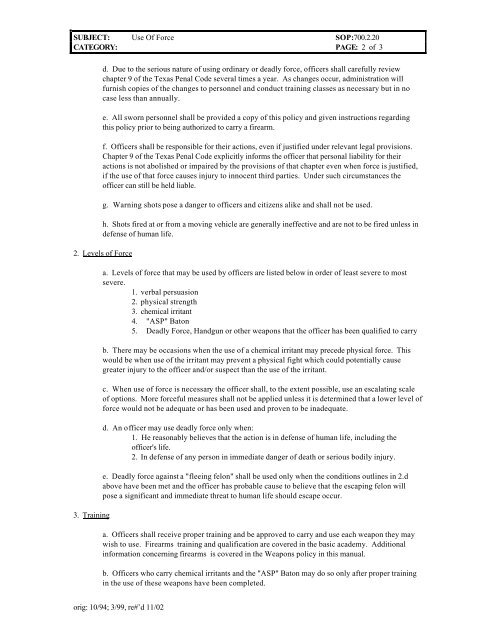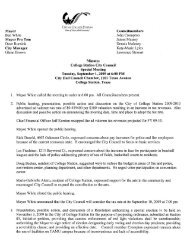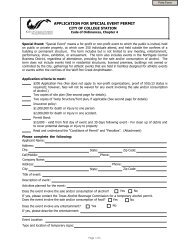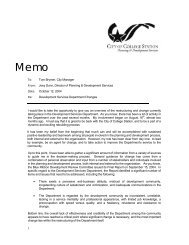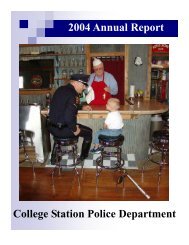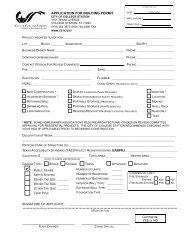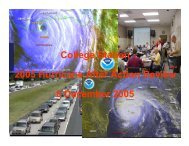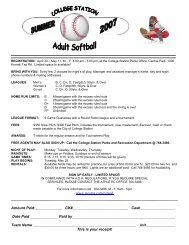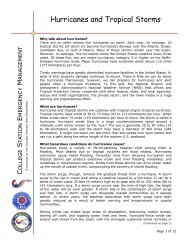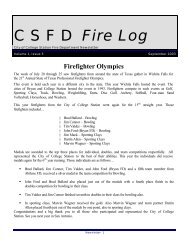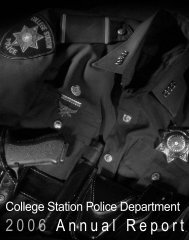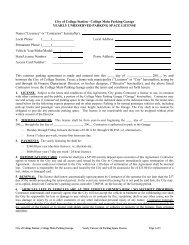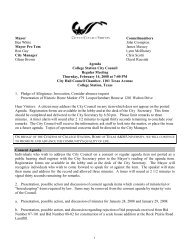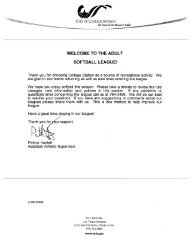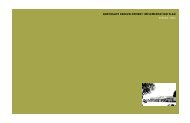standard operating procedure college station fire department
standard operating procedure college station fire department
standard operating procedure college station fire department
Create successful ePaper yourself
Turn your PDF publications into a flip-book with our unique Google optimized e-Paper software.
SUBJECT: Use Of Force SOP:700.2.20<br />
CATEGORY: PAGE: 2 of 3<br />
d. Due to the serious nature of using ordinary or deadly force, officers shall carefully review<br />
chapter 9 of the Texas Penal Code several times a year. As changes occur, administration will<br />
furnish copies of the changes to personnel and conduct training classes as necessary but in no<br />
case less than annually.<br />
e. All sworn personnel shall be provided a copy of this policy and given instructions regarding<br />
this policy prior to being authorized to carry a <strong>fire</strong>arm.<br />
f. Officers shall be responsible for their actions, even if justified under relevant legal provisions.<br />
Chapter 9 of the Texas Penal Code explicitly informs the officer that personal liability for their<br />
actions is not abolished or impaired by the provisions of that chapter even when force is justified,<br />
if the use of that force causes injury to innocent third parties. Under such circumstances the<br />
officer can still be held liable.<br />
g. Warning shots pose a danger to officers and citizens alike and shall not be used.<br />
h. Shots <strong>fire</strong>d at or from a moving vehicle are generally ineffective and are not to be <strong>fire</strong>d unless in<br />
defense of human life.<br />
2. Levels of Force<br />
3. Training<br />
a. Levels of force that may be used by officers are listed below in order of least severe to most<br />
severe.<br />
1. verbal persuasion<br />
2. physical strength<br />
3. chemical irritant<br />
4. "ASP" Baton<br />
5. Deadly Force, Handgun or other weapons that the officer has been qualified to carry<br />
b. There may be occasions when the use of a chemical irritant may precede physical force. This<br />
would be when use of the irritant may prevent a physical fight which could potentially cause<br />
greater injury to the officer and/or suspect than the use of the irritant.<br />
c. When use of force is necessary the officer shall, to the extent possible, use an escalating scale<br />
of options. More forceful measures shall not be applied unless it is determined that a lower level of<br />
force would not be adequate or has been used and proven to be inadequate.<br />
d. An officer may use deadly force only when:<br />
1. He reasonably believes that the action is in defense of human life, including the<br />
officer's life.<br />
2. In defense of any person in immediate danger of death or serious bodily injury.<br />
e. Deadly force against a "fleeing felon" shall be used only when the conditions outlines in 2.d<br />
above have been met and the officer has probable cause to believe that the escaping felon will<br />
pose a significant and immediate threat to human life should escape occur.<br />
a. Officers shall receive proper training and be approved to carry and use each weapon they may<br />
wish to use. Firearms training and qualification are covered in the basic academy. Additional<br />
information concerning <strong>fire</strong>arms is covered in the Weapons policy in this manual.<br />
b. Officers who carry chemical irritants and the "ASP" Baton may do so only after proper training<br />
in the use of these weapons have been completed.<br />
orig: 10/94; 3/99, re#’d 11/02


